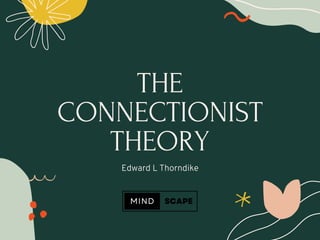The CONNECTIONIST THEORY
•
0 likes•285 views
This slide explains the key concepts and principles of Thorndike's theory, including experiments with animals, such as puzzle boxes, and how these experiments contributed to his theory.
Report
Share
Report
Share
Download to read offline

Recommended
Recommended
More Related Content
What's hot
What's hot (20)
Similar to The CONNECTIONIST THEORY
Similar to The CONNECTIONIST THEORY (20)
UNITS TWO APPROACES 1 BEHAVIOURISM (1) [Autosaved].pptx![UNITS TWO APPROACES 1 BEHAVIOURISM (1) [Autosaved].pptx](data:image/gif;base64,R0lGODlhAQABAIAAAAAAAP///yH5BAEAAAAALAAAAAABAAEAAAIBRAA7)
![UNITS TWO APPROACES 1 BEHAVIOURISM (1) [Autosaved].pptx](data:image/gif;base64,R0lGODlhAQABAIAAAAAAAP///yH5BAEAAAAALAAAAAABAAEAAAIBRAA7)
UNITS TWO APPROACES 1 BEHAVIOURISM (1) [Autosaved].pptx
Edward Thorndike law of effect, Theory of Learning, Trial and Error theory

Edward Thorndike law of effect, Theory of Learning, Trial and Error theory
More from Blesson Varghese
More from Blesson Varghese (7)
Recently uploaded
God is a creative God Gen 1:1. All that He created was “good”, could also be translated “beautiful”. God created man in His own image Gen 1:27. Maths helps us discover the beauty that God has created in His world and, in turn, create beautiful designs to serve and enrich the lives of others.
Explore beautiful and ugly buildings. Mathematics helps us create beautiful d...

Explore beautiful and ugly buildings. Mathematics helps us create beautiful d...christianmathematics
Recently uploaded (20)
Explore beautiful and ugly buildings. Mathematics helps us create beautiful d...

Explore beautiful and ugly buildings. Mathematics helps us create beautiful d...
Web & Social Media Analytics Previous Year Question Paper.pdf

Web & Social Media Analytics Previous Year Question Paper.pdf
Ecosystem Interactions Class Discussion Presentation in Blue Green Lined Styl...

Ecosystem Interactions Class Discussion Presentation in Blue Green Lined Styl...
Kisan Call Centre - To harness potential of ICT in Agriculture by answer farm...

Kisan Call Centre - To harness potential of ICT in Agriculture by answer farm...
Measures of Dispersion and Variability: Range, QD, AD and SD

Measures of Dispersion and Variability: Range, QD, AD and SD
social pharmacy d-pharm 1st year by Pragati K. Mahajan

social pharmacy d-pharm 1st year by Pragati K. Mahajan
Call Girls in Dwarka Mor Delhi Contact Us 9654467111

Call Girls in Dwarka Mor Delhi Contact Us 9654467111
The CONNECTIONIST THEORY
- 2. Edward Lee Thorndike AMERICAN PSYCHOLOGIST| FATHER OF EDUCATIONAL PSYCHOLOGY
- 3. Thorndike placed a hungry cat inside a box that had a latch that could be opened by manipulating a lever. At first, the cat would engage in random movements, but eventually, through trial and error, it would learn to operate the lever and escape from the box. Thorndike observed that the cats were able to learn to escape from the box more quickly with repeated trials, suggesting that learning occurred through a process of trial and error. The puzzle box experiment
- 4. Sum up of the Experiment Drive: In the experiment, it was hunger and was intensified by the sight of food. Goal: To get at the food by getting out of the box. Block: The cat was confined in a box with a closed door. Random Movements: The cat persistently tried to come out of the box without knowing how. Chance Success: As a result of this striving and random movements the cat, by chance, succeeded in opening the door. Selection (of proper movement): Gradually, the cat recognized the correct way to manipulate the latch. Fixation: The cat learned the proper way to open the door by eliminating all the incorrect responses ad fixing only the right response.
- 5. Theoretical Principles Learning involves trial and error. Learning is the stamping in of the correct responses and stamping out of the incorrect responses through the process of trial and error. Learning is the result of the formation of connection. Learning is the result of the formation of the connection between the stimuli and the response. Strengthening or weakening of this bond or connection results in the making or breaking of habits. This system is called connectionism.
- 6. Theoretical Principles Learning is incremental Thorndike concluded that learning performance is dependent upon the number of trials or opportunities fulfilled by the learner. As we go on increasing the number of trials or practices, our performance gradually improves. Thorndike termed such improvement in performance as incremental. Learning is direct Learning is not mediated by thinking, reasoning, or other such mental functions. Learning is a process of establishing a simple connection between sensory stimuli and appropriate responses.